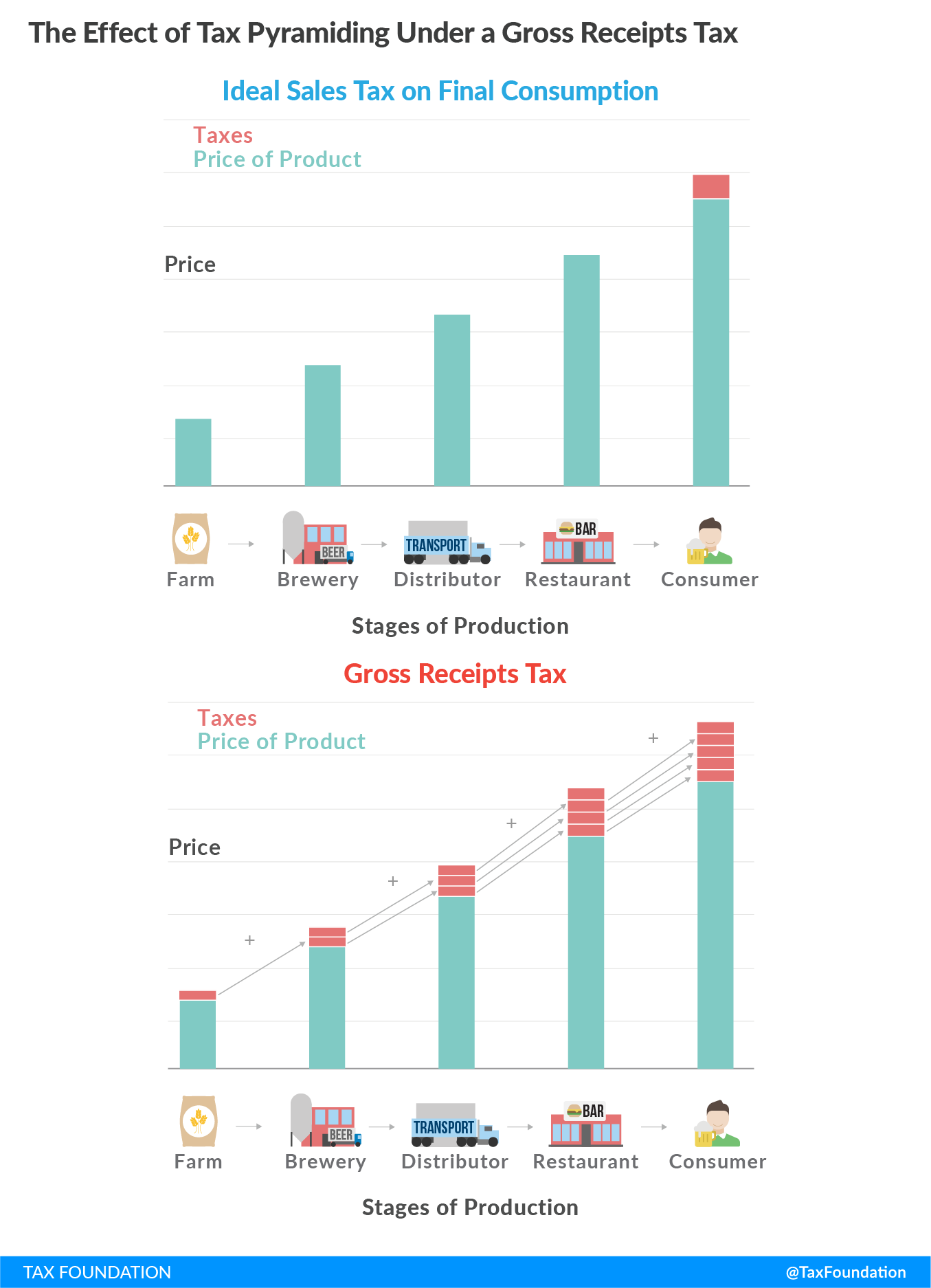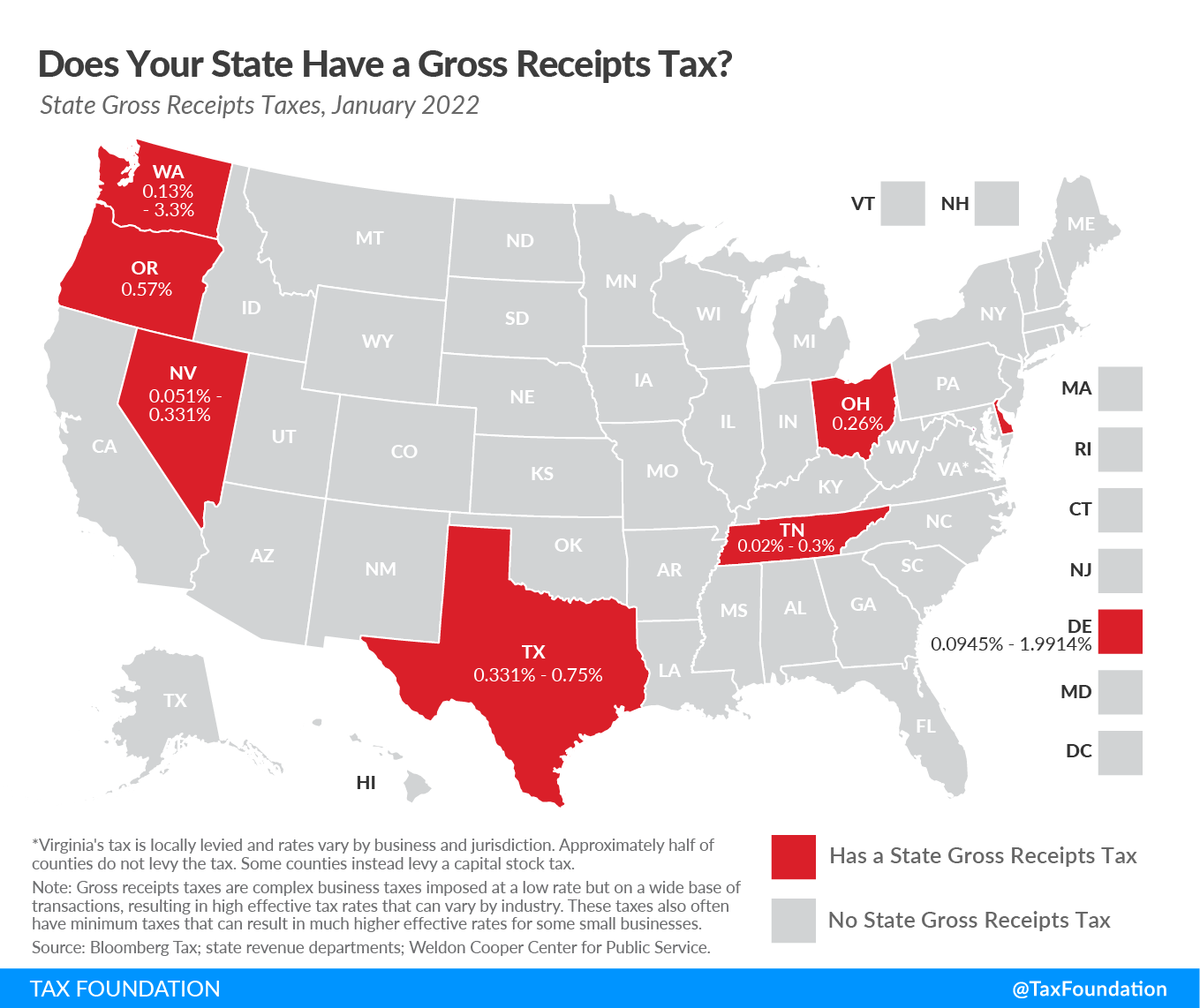
Today’s map looks at which states levy a gross receipts tax, which is often considered one of the most economically damaging taxes. Shifting from state gross receipts taxes would represent a pro-growth change to make tax A tax is a mandatory payment or charge collected by local, state, and national governments from individuals or businesses to cover the costs of general government services, goods, and activities. codes friendlier to businesses and consumers alike, which is especially necessary in an increasingly mobile economy.
Gross receipts taxes are applied to a company’s gross sales, without deductions for a firm’s business expenses, like compensation and cost of goods sold. These taxes are imposed at each stage of the production process, leading to tax pyramiding.

Seven states (Delaware, Nevada, Ohio, Oregon, Tennessee, Texas, and Washington) currently levy gross receipts taxes, while several others, including Pennsylvania, Virginia, and West Virginia, permit local taxes imposed on a gross receipts base. South Carolina converted a local gross receipts tax A gross receipts tax, also known as a turnover tax, is applied to a company’s gross sales, without deductions for a firm’s business expenses, like costs of goods sold and compensation. Unlike a sales tax, a gross receipts tax is assessed on businesses and apply to business-to-business transactions in addition to final consumer purchases, leading to tax pyramiding. into a tax on net income (profits) in 2020. Gross receipts taxes gained popularity among states in the 1930s but began to be repealed or struck down as unconstitutional by state courts in the 1970s. Although they have been dismissed for decades as inefficient and unsound policy, they have returned in recent years as states seek to limit revenue volatility and to replace revenue lost by eroding corporate income tax bases.

As the map indicates, states often designate multiple gross receipts rates, typically by industry, to mitigate some of the economic costs associated with these taxes. Businesses and industries with lower profit margins or more stages in the production process—each one taxed separately—are hit harder by gross receipts taxes than are high-margin businesses that are vertically integrated, meaning that more of the work is done in-house (resulting in less exposure to the tax because there are fewer transactions). Differential rates attempt, albeit somewhat crudely, to adjust for these differences on an industry-by-industry basis. Washington’s Business and Occupation Tax has the highest top rate of 3.3 percent, followed by Delaware’s Manufacturers’ and Merchants’ License Tax with a top rate of 1.9914 percent. Ohio and Oregon have flat rates of 0.26 percent and 0.57 percent, respectively.
The tax base The tax base is the total amount of income, property, assets, consumption, transactions, or other economic activity subject to taxation by a tax authority. A narrow tax base is non-neutral and inefficient. A broad tax base reduces tax administration costs and allows more revenue to be raised at lower rates. and allowable expenditures vary depending on the design of the gross receipts tax. Texas’ Margin Tax allows for a choice of deducting compensation or the cost of goods sold. Nevada allows a firm to deduct 50 percent of its Commerce Tax liability over the previous four quarters from payments for the state’s payroll tax. And Oregon allows a 35 percent deduction for the greater of compensation or cost of goods sold.
Gross receipts taxes impact firms with low profit margins and high production volumes, as the tax does not account for a business’ costs of production as a corporate income tax would. These taxes can be particularly severe for start-ups and entrepreneurs, who typically post losses in early years while still owing gross receipts payments.
These taxes also do not focus on final consumption, as a well-structured sales tax would. They penalize companies that include multiple transactions in their production process, with the tax imposed on each stage of production—called tax pyramiding Tax pyramiding occurs when the same final good or service is taxed multiple times along the production process. This yields vastly different effective tax rates depending on the length of the supply chain and disproportionately harms low-margin firms. Gross receipts taxes are a prime example of tax pyramiding in action. . Prices rise as these intermediate taxes are shifted onto consumers, impacting those with lower incomes the most.
Gross receipts taxes impose costs on consumers, workers, and shareholders alike. Shifting from these economically damaging taxes can thus be a part of states’ plans for improving their tax codes in an increasingly competitive tax landscape.